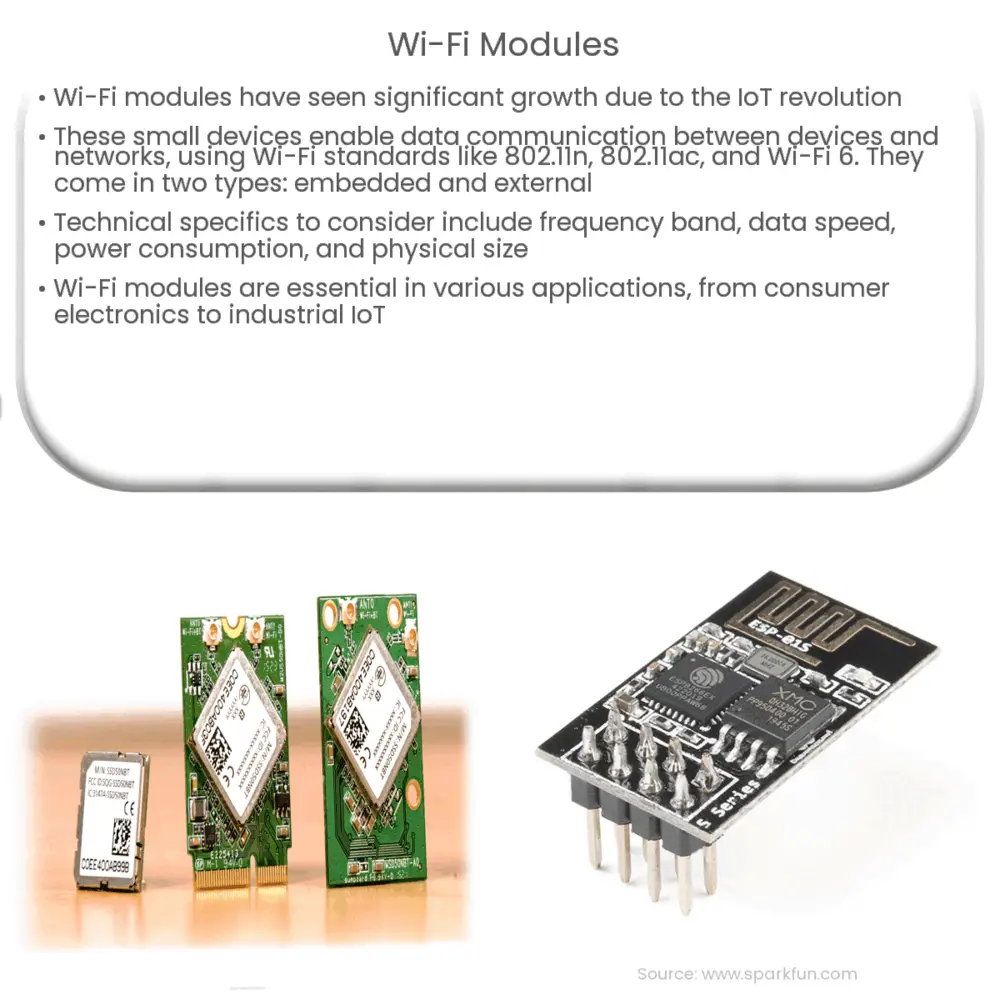Explore the world of Wi-Fi modules: their types, technical specifics, applications, and future trends in wireless communication.

Introduction to Wi-Fi Modules
Wireless technology has seen an explosive growth in the past decade, particularly in the domain of Internet of Things (IoT). A crucial component enabling this wireless revolution is the Wi-Fi module. In this article, we delve into understanding these modules, their types, applications, and some relevant technical specifics.
Understanding Wi-Fi Modules
Wi-Fi modules are small devices integrated into various gadgets and equipment that allow them to connect to a Wi-Fi network. These modules provide a means for data communication between the device and the network, leveraging the Wi-Fi standard protocols such as 802.11n, 802.11ac, or the latest 802.11ax (also known as Wi-Fi 6).
Equipped with a wireless network interface controller, an antenna, and sometimes an onboard processor, these modules can be either embedded into a device or added as an external unit. They are crucial to numerous applications, from consumer electronics like laptops and smartphones to industrial IoT devices.
Types of Wi-Fi Modules
Wi-Fi modules can broadly be classified into two types:
- Embedded Wi-Fi Modules: These are incorporated directly onto the device during manufacturing. Embedded modules are commonly found in devices like smartphones, smart home appliances, and automotive systems.
- External Wi-Fi Modules: These are not built into the device but rather added on as per need. They are often used in computers through a USB port. Such modules offer flexibility as they can be upgraded or replaced without altering the entire device.
Technical Specifics
While considering a Wi-Fi module, some important technical aspects include its frequency band, data transfer speed, power consumption, range, and physical dimensions. Most Wi-Fi modules operate on either the 2.4 GHz or the 5 GHz frequency band. The choice between these frequencies often involves a trade-off between range and data speed. The 2.4 GHz band provides longer range but slower data speeds compared to the 5 GHz band.
Data transfer speed, measured in Mbps or Gbps, is another vital feature. The advent of Wi-Fi 6 has seen modules capable of achieving speeds up to 9.6 Gbps. Power consumption is crucial, especially for battery-operated IoT devices. Additionally, the physical dimensions of a module are significant, particularly for space-constrained applications.
Applications of Wi-Fi Modules
The versatility of Wi-Fi modules extends to a myriad of applications in both consumer and industrial domains.
- Consumer Electronics: Laptops, smartphones, tablets, smart TVs, gaming consoles, and e-readers all employ Wi-Fi modules to connect to the internet.
- Home Automation: Smart home devices such as security systems, thermostats, and appliances utilize Wi-Fi modules for remote control and monitoring.
- Industrial IoT: Wi-Fi modules enable remote operation and data collection for numerous industrial equipment, including machinery, sensors, and control systems.
- Healthcare: Medical devices like wearable monitors, telehealth systems, and hospital equipment use Wi-Fi modules for data transmission and cloud connectivity.
Choosing the Right Wi-Fi Module
Selecting the appropriate Wi-Fi module for a specific application can be challenging, considering the vast range of options available. It’s vital to consider the module’s compatibility with the device, range requirements, power consumption, data transfer speeds, and the targeted Wi-Fi standard.
Additionally, considerations around cost, module size, and environmental factors like operating temperature ranges and humidity conditions should also be taken into account. In many cases, manufacturers provide evaluation kits that allow users to test the module’s performance before making a final decision.
Future of Wi-Fi Modules
With the advent of newer Wi-Fi standards such as Wi-Fi 6 and Wi-Fi 6E, Wi-Fi modules are set to become even more capable, providing faster speeds, lower latency, and improved performance in congested areas. Furthermore, the development of Wi-Fi 7 (802.11be) is underway, promising to enhance capabilities further, making Wi-Fi modules an indispensable part of future wireless communication.
Conclusion
In conclusion, Wi-Fi modules play a pivotal role in today’s wireless communication landscape, underpinning an array of devices and applications. Their potential to transform and enable efficient data communication makes them a cornerstone in the Internet of Things ecosystem. As wireless technology continues to evolve, Wi-Fi modules are expected to provide even greater connectivity solutions, opening new avenues for innovation and growth in the digital world.

